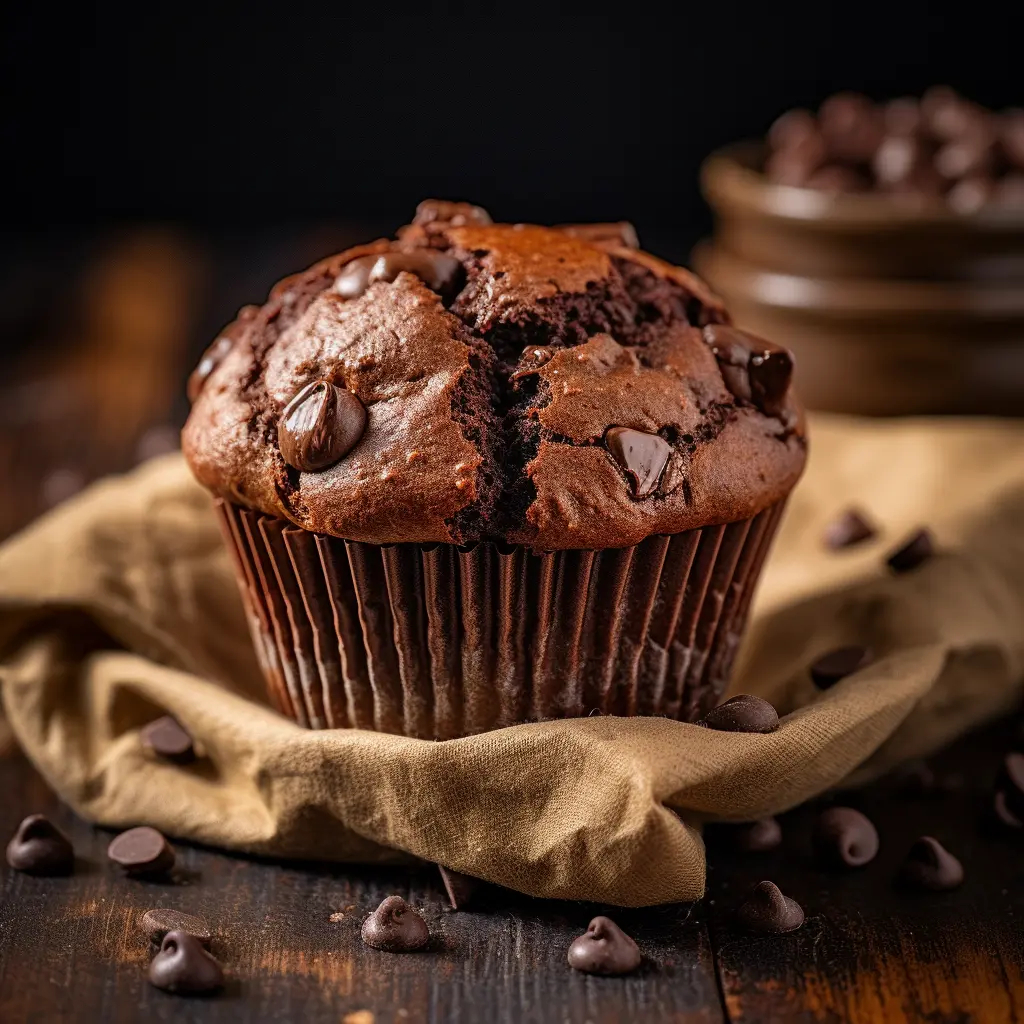This guide teaches you how to make delicious chocolate muffins. We’ll cover the ingredients, what they do, and step-by-step instructions. We’ll explain different ways to make them, including variations for different tastes.
Table of Contents
Chocolate Muffins Types and Textures
Muffin Sizes
Muffins come in different sizes. Mini muffins are small, perfect for snacks. Jumbo muffins are much bigger. The size changes the baking time.
Muffin Texture
The texture of a muffin depends on the ingredients and how you mix them. Too much mixing makes a tough muffin. A gentle mix creates a lighter, fluffier muffin. The type of flour also matters.
Ingredients and Texture
Different ingredients give different textures. For example, adding more oil makes a moister muffin. Using less liquid makes a denser muffin.
Common Mistakes
Overmixing is a big mistake. It makes the gluten in the flour tighten up, resulting in a tough muffin. Don’t mix the batter more than necessary. Make sure to use fresh baking powder and vinager for the best rise.
Chocolate Goodness: Choosing Your Cocoa
Cocoa Powder Choices
We have two main cocoa powders: unsweetened and Dutch-processed. Unsweetened cocoa powder gives a more acidic, tangy taste. Dutch-processed cocoa powder has been treated with an alkali. This treatment makes it less acidic and gives a richer, darker color. It also has a smoother, less bitter flavor.
Sweetening Your Muffins
Adding chocolate chips is a simple way to add chocolate flavor and texture. You can use milk chocolate, dark chocolate, or semi-sweet chips. Melting chocolate and mixing it into the batter adds intense chocolate flavor and a smooth, rich texture.
Chocolate’s Impact on Muffins
The type of chocolate you use affects your muffin’s color and taste. Unsweetened cocoa powder makes lighter muffins. Dutch-processed cocoa powder gives darker, richer muffins. Adding chocolate chips adds texture and boosts the chocolate taste. Melting chocolate creates a very intense, decadent chocolate flavor throughout the muffin.
Essential Ingredients: Gathering Your Supplies
This section lists the main ingredients you need to make delicious chocolate muffins. We’ll also talk about what you can use instead of some ingredients if needed.
| Ingredients | Quantity | Note |
|---|---|---|
| Flour | (Amount will depend on your recipe) | All-purpose flour works best. |
| Sugar | (Amount will depend on your recipe) | Granulated sugar is standard. |
| Cocoa Powder | (Amount will depend on your recipe) | Unsweetened or Dutch-processed. |
| Eggs | (Amount will depend on your recipe) | Large eggs are usually used. |
| Milk | (Amount will depend on your recipe) | Any kind of milk works. |
| Oil | (Amount will depend on your recipe) | Vegetable oil is common. |
| Baking Powder | (Amount will depend on your recipe) | Use fresh baking powder for the best rise. |
| Vanilla | (Amount will depend on your recipe) | Vanilla extract adds flavor. |
Remember, the exact amount of each ingredient depends on the specific muffin recipe you are using. Always check your recipe carefully before you begin!
Chocolate Muffins The Right Technique
Combining Wet and Dry Ingredients
First, mix the wet ingredients together in one bowl. This usually includes eggs, milk, oil, and vanilla. Then, in a separate bowl, mix the dry ingredients: flour, sugar, cocoa powder, and baking powder. Gently pour the wet ingredients into the dry ingredients. Stir until just combined. Don’t overmix!
Why Not to Overmix
Overmixing develops the gluten in the flour. Gluten makes the muffins tough and chewy. We want light and fluffy muffins! Mix only until you no longer see dry ingredients. A few lumps are okay.
Mixing Methods
You can use a whisk or a spatula to mix the batter. A whisk works well for combining the wet ingredients, while a spatula is good for gently folding the wet into the dry ingredients and scraping the bowl. Don’t use a mixer unless your recipe specifically says to. A mixer can easily overmix the batter.
Baking Your Chocolate Muffins: Oven Temperature and Timing
Preheat Your Oven
Preheat your oven to the temperature your recipe says. This is very important! It makes sure your muffins bake evenly. Most recipes call for a temperature between 350°F (175°C) and 400°F (200°C). Check your oven’s temperature with an oven thermometer for accuracy.
Filling the Muffin Tin
Fill each muffin cup about two-thirds full. Don’t overfill them; the batter will rise. Using a muffin scoop or ice cream scoop helps make all your muffins the same size and bake evenly. Lightly grease the muffin tin or use paper liners to prevent sticking.
Baking Time
Baking times depend on the size of your muffins and your oven. Small muffins bake faster than large ones. Recipes usually give a time range, like 15-20 minutes. Start checking for doneness around the minimum time.
Checking for Doneness
A toothpick inserted into the center should come out clean. If there’s batter on the toothpick, bake for a few more minutes and check again. The tops of the muffins should be lightly browned and spring back when touched gently.
Avoiding Burning
If the tops are browning too quickly, loosely cover them with aluminum foil. Keep a close eye on them during the last few minutes of baking. Overbaked muffins will be dry and crumbly. Remove them from the oven as soon as they are done. Let them cool in the tin for a few minutes before moving them to a wire rack to cool completely.
Cooling and Storage: Keeping Your Chocolate Muffins Fresh
Cooling Your Muffins
Let your muffins cool in the muffin tin for a few minutes after baking. This prevents them from breaking. Then, move them to a wire rack to cool completely. Don’t rush this step; completely cooled muffins store better.
Storing Muffins
Keep muffins in an airtight container at room temperature for up to three days. This keeps them moist and fresh.
Freezing Muffins
Freezing is a great way to save muffins for later. Let them cool completely. Then, wrap each muffin individually in plastic wrap, and place them in a freezer bag. Frozen muffins can last for several months. To enjoy, thaw them overnight in the refrigerator. You can also warm them briefly in the microwave or oven.
Flavor Variations: Beyond Basic Chocolate
Nuts in Chocolate Muffins
Adding nuts like walnuts, pecans, or almonds gives your muffins a crunchy texture and a boost of flavor. Chopped nuts mix well into the batter.
Different Chocolates
Experiment with different types of chocolate chips. Milk chocolate chips are sweet. Dark chocolate chips are richer and less sweet. Semi-sweet chocolate chips offer a balance. You can also melt chocolate and add it to the batter for an intense chocolate flavor.
Extracts for Flavor
A little vanilla extract is common, but you can also try almond extract, peppermint extract, or orange extract for unique flavors. Remember to use these extracts sparingly; a little goes a long way.
Spices
A dash of cinnamon, nutmeg, or even a pinch of chili powder can add warmth and complexity to your chocolate muffins. Experiment to find your favorite spice combinations.
Troubleshooting Common Problems
Dry Muffins
Dry muffins usually mean you didn’t add enough liquid. Next time, add a little more milk or oil. Make sure your baking powder is fresh; old baking powder doesn’t work as well.
Dense Muffins
Dense muffins often happen from overmixing. Mix your wet and dry ingredients only until they’re just combined. A few lumps are okay. Overmixing makes the gluten in the flour tighten up, resulting in a tough muffin. Don’t use a mixer unless the recipe says to.
Fallen Muffins
Fallen muffins might mean your oven wasn’t hot enough, or your baking powder was old. Always preheat your oven to the temperature in your recipe. Use fresh baking powder and vinager for the best rise. Also, don’t open the oven door too often while they’re baking. That can let the heat escape and cause them to fall.
Frequently Asked Questions
What causes tough muffins?
Tough muffins are usually caused by overmixing the batter. Overmixing creates gluten, making the muffins chewy. Mix only until the dry ingredients are just moistened. A few lumps are okay. Using fresh baking powder and vinager is also important for a good rise.
Why did my muffins sink in the middle?
Muffins sinking often means the oven wasn’t hot enough, or your baking powder might be old. Always preheat your oven properly. Using fresh baking powder is important for a good rise. Also, avoid opening the oven door too much while baking.
How can I make moister muffins?
Adding more oil to your recipe usually makes moister muffins. Make sure your baking powder and vinager are fresh. Also, don’t overbake them. Check for doneness with a toothpick.
What kind of cocoa powder should I use?
You can use either unsweetened or Dutch-processed cocoa powder. Unsweetened cocoa powder gives a more acidic taste. Dutch-processed cocoa powder has a smoother, less bitter flavor and a richer color. The choice affects the muffin’s final color and taste.
My muffins are burning on top, what can I do?
If the tops of your muffins are browning too fast, loosely cover the muffin tin with aluminum foil during the last few minutes of baking. This will prevent them from burning while the inside finishes baking. Always keep a close eye on them as they finish.
Conclusion: Baking Success
Enjoy Your Chocolate Muffins!
This guide gave you the tools to make delicious chocolate muffins. You learned about ingredients, mixing techniques, and baking tips. Remember, practice makes perfect! Don’t be afraid to experiment with different flavors and types of chocolate.
Tips for Baking Success
- Use fresh baking powder and vinager for the best rise.
- Don’t overmix the batter—it makes tough muffins.
- Preheat your oven to the correct temperature.
- Check for doneness with a toothpick.
- Let muffins cool completely before storing.
This guide will help you bake delicious chocolate muffins. Remember to follow the steps carefully and have fun!
- visit our Instagram page

